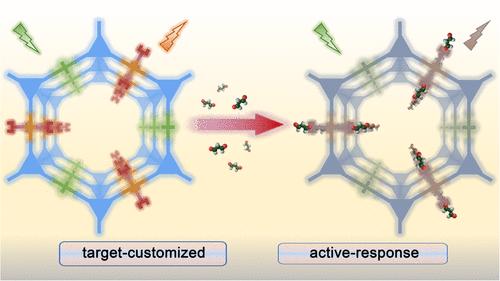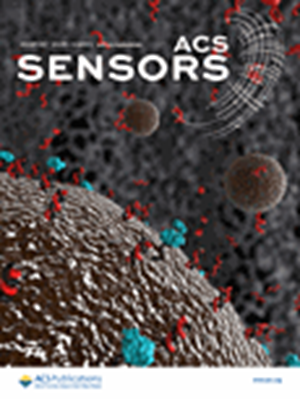Construction of Guanidinium-Functionalized Covalent Organic Frameworks via Phototriggered Click Reaction as a Dual-Mode Accurate Sensor for Malondialdehyde
IF 8.2
1区 化学
Q1 CHEMISTRY, ANALYTICAL
引用次数: 0
Abstract
Malondialdehyde (MDA) serves as a pivotal indicator to estimate the lipid peroxidation status and as a biomarker for the assessment of oxidative stress and screening of disease by people excretion. However, most of the existing analytical methods for MDA suffer from complicated derivation, leading to poor accuracy and inconvenience. In this work, the guanidinium-functionalized covalent organic framework (COF) was delicacy-designed and used to tune the modular structure by the building blocks with condensation, phototriggered click reaction, and further guanidylation process. A methoxy-group-containing linker in the skeleton was adopted to form lone-pair delocalized oxygen atoms, trigger the resonance effect, attenuate the polarization of the C═N bond linkages, and weaken the interlayer repulsion, supporting the stability of the guest gating COF. The available guanidino groups grew from the ordered pore walls of the COF and served as the customized talon with an enhanced interaction site density to rapidly grab the target guest by charge-assisted strong hydrogen bonds and electrostatic attraction forces. This distinctive feature significantly bolstered sensitive signal transduction, enabling rapid MDA sensing (within 120 s) without derivation treatment, and achieved a calculated limit of detection (LOD) as low as 0.08 μM. With the accessible image-data transmission process, the portable dual-channel sensing platform achieved sensitive and accurate MDA monitoring.

求助全文
约1分钟内获得全文
求助全文
来源期刊

ACS Sensors
Chemical Engineering-Bioengineering
CiteScore
14.50
自引率
3.40%
发文量
372
期刊介绍:
ACS Sensors is a peer-reviewed research journal that focuses on the dissemination of new and original knowledge in the field of sensor science, particularly those that selectively sense chemical or biological species or processes. The journal covers a broad range of topics, including but not limited to biosensors, chemical sensors, gas sensors, intracellular sensors, single molecule sensors, cell chips, and microfluidic devices. It aims to publish articles that address conceptual advances in sensing technology applicable to various types of analytes or application papers that report on the use of existing sensing concepts in new ways or for new analytes.
 求助内容:
求助内容: 应助结果提醒方式:
应助结果提醒方式:


